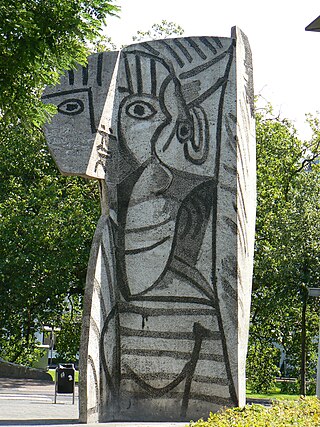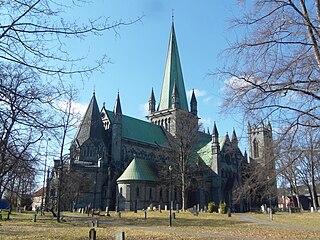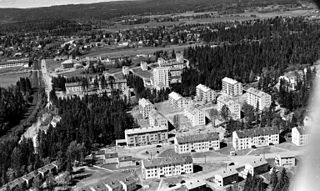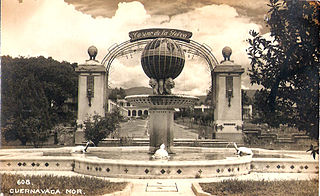
Modern architecture was an architectural movement and style that was prominent in the 20th century, between the earlier Art Deco and later postmodern movements. Modern architecture was based upon new and innovative technologies of construction ; the principle functionalism ; an embrace of minimalism; and a rejection of ornament.

The National Museum of Art, Architecture and Design, or simply the National Museum, is a museum, located in Oslo, Norway. It holds the Norwegian state's public collection of art, architecture, and design objects. The collection totals over 400,000 works, amongst them the first copy of Edvard Munch's The Scream from 1893. The museum is state-owned and managed by the Norwegian Ministry of Culture.

The Oslo School of Architecture and Design is an autonomous institution within the Norwegian university system. The School offers a unique research-based education with a strong international standing within the fields of architecture, urbanism, design, and landscape architecture.

Sylvette is a large concrete sculpture created by Pablo Picasso and the Norwegian artist Carl Nesjar, which was erected in the city of Rotterdam in 1970. It is located on the corner of Westersingel next to the Museum Boijmans Van Beuningen. The sculpture portrays a young woman with a ponytail. The model for the sculpture was Sylvette David, whom Picasso met in 1953 when she was 19. The sculpture was produced following the creation of a series of artworks, known as the Sylvette series, that Picasso made of his muse in a variety of artistic styles.

The Williamsburg Houses, originally called the Ten Eyck Houses, is a public housing complex built and operated by the New York City Housing Authority (NYCHA), in the Williamsburg neighborhood of Brooklyn. It consists of 20 buildings on a site bordered by Scholes, Maujer, and Leonard Streets and Bushwick Avenue. The Williamsburg Houses were built in 1936–1938 under the auspices of the Housing Division of the Public Works Administration (PWA). Richmond Shreve was the chief architect of the project; the design team of nine other architects was led by the Swiss-American modernist William Lescaze. The construction contract was awarded to Starrett Brothers & Eken. The designs called for the inclusion of modern art commissioned through the Federal Arts Project.

The University Village is a complex of three apartment buildings located in Greenwich Village in the Lower Manhattan-part of New York City. The complex is owned by New York University and was built in the 1960s as part of the university's transition to a residential college. It is composed of 505 LaGuardia Place, a co-op that does not house students, and Silver Tower I and Silver Tower II, which house faculty and graduate students of NYU. The buildings were designed by modern architects James Ingo Freed and I. M. Pei, and the central plaza contains a sculpture by Carl Nesjär and Pablo Picasso. In 2008 the complex became a New York City designated landmark.

Regjeringskvartalet is a collection of buildings located in the centre of Norway's capital city Oslo, housing several offices for the Norwegian Government. The complex is situated approximately 300m northeast of the Parliament Building, and consists of nine buildings with about 1,960,000 sq f (182,000 m²) of office space for approximately 4,430 people.

Johan Nygaardsvolds plass is a town square in Oslo, Norway.

The Law Courts building is part of the landmark Robson Square complex in downtown Vancouver, British Columbia, Canada. It was designed by renowned Canadian architect Arthur Erickson. The Law Courts building occupies the southern block of the three city block complex, provincial government offices the middle block, and the Vancouver Art Gallery the northern block. The building is used exclusively by the two higher courts of the Province of British Columbia: the Supreme Court and the Court of Appeal.

Erling Viksjø was a Norwegian architect. Viksjø was an early exponent of architectural modernism. He was also noted for his use of textured concrete as a building material in a number of his designs.

Carl Nesjar was a Norwegian painter, sculptor and graphic artist. He is best known for his collaborations with Pablo Picasso; serving for nearly twenty years as Picasso's chosen fabricator — the artist who turned Picasso's drawings and scale models into large public sculptures. One such work was Picasso's Regjeringskvartalet murals which are located in Oslo, the city where Nesjar lived for most of his life. He is also known for his series of "Ice Fountains” which can be found in cities around the world.

Church building in Norway began when Christianity was established there around the year 1000. The first buildings may have been post churches erected in the 10th or 11th century, but the evidence is inconclusive. For instance under Urnes Stave Church and Lom Stave Church there are traces of older post churches. Post churches were later replaced by the more durable stave churches. About 1,300 churches were built during the 12th and 13th centuries in what was Norway's first building boom. A total of about 3,000 churches have been built in Norway, although nearly half of them have perished. From 1620 systematic records and accounts were kept although sources prior to 1620 are fragmented. Evidence about early and medieval churches is partly archaeological. The "long church" is the most common type of church in Norway. There are about 1620 buildings recognized as churches affiliated with the Church of Norway. In addition, there are a number of gospel halls belonging to the lay movement affiliated with the Church of Norway as well as churches belonging to other Christian bodies. Until the 20th century, most churches were built from wood. 220 buildings are protected by law, and an additional 765 are listed as valuable cultural heritage.

The Second Townsville General Hospital is a heritage-listed former hospital and now an apartment building at 24 Eyre Street, North Ward, Townsville, City of Townsville, Queensland, Australia. It was designed by Donoghue & Fulton and built from 1945 to 1951. It is also known as North Ward Hospital. It was added to the Queensland Heritage Register on 26 April 1996.

Holmen is a neighbourhood in Oslo and forms part of the district of Vestre Aker. It is situated between Hovseter in the west and Slemdal in the east, Holmenkollen in the north and Makrellbekken in the south. The name is derived from the Holmen farms.

The Hotel Casino de la Selva was a hotel and casino located in the city of Cuernavaca, Mexico. The main building was opened in 1931 as a hotel and casino, but from 1934 it was used only as a hotel. Additions in the late 1950s included buildings designed by the architect Félix Candela that were roofed by reinforced concrete paraboloid shells. The interior was decorated with murals by well-known Mexican and Spanish artists. After the 1970s the hotel went into decline, and in 1994 was sold to a hotel chain that failed to pay taxes on the property. It was seized by the Mexican government and was auctioned off in 2001 as a site for construction of a discount store and a hypermarket. After demolition had begun there was a public outcry, and eventually some parts of the murals were preserved.
The State Office Block was a landmark modernist skyscraper complex on a block bounded by Phillip, Bent and Macquarie streets in the Sydney central business district. Completed in 1965 and designed in the modernist International style by Ken Woolley from the NSW Government Architect's Office, the 128-metre-high building took the title of the tallest building in Australia from the nearby AMP Building until 1967, the 170 metre Australia Square tower was completed. Designed to hold offices of the NSW Government, including the cabinet and the Premier's office, the State Office Block was demolished in 1997 to make way Aurora Place.

The Edificio del Seguro Médico is a commercial building in El Vedado, Havana. Built between 1955 and 1958, it was designed as a mixed use building for apartments and offices for the headquarters of the National Medical Insurance Company by Antonio Quintana Simonetti.

Bakkehaugen Church is a church, located in the neighborhood of Tåsen in Oslo, Norway.

The Y-Block was a building in Oslo, Norway, extant from 1970 to 2020. The building, designed in a Brutalist style by Erling Viksjø, was part of the Regjeringskvartalet in the centre of the city. It featured two murals by Pablo Picasso. It was one of few sites with murals designed by Picasso, along with the Château de Castille in France and the Col·legi d'Arquitectes de Catalunya in Barcelona.


















